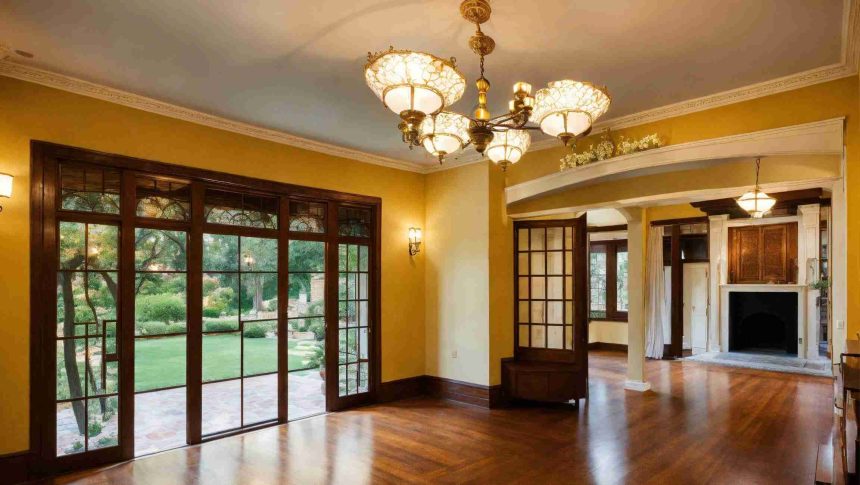The ceiling is often an overlooked design element in most homes. Yet creative and unique ceiling trim can really make a space stand out and add visual interest. From traditional crown moulding to modern beam accents, there are many stylish ways to dress up your ceilings.
Benefits of Installing Ceiling Trim
- Defines Spaces: Strategically placing ceiling trim can help differentiate various zones in an open floor plan. You can define the living room from the dining area or mark off a reading nook using various ceiling trim styles.
- Draws the Eye Upward: ceiling trim attracts the eye upward, which can make rooms feel larger and more open. This helps balance out darker or busier wall colors.
- Adds Architectural Interest: Plain white ceilings with sharp corners can feel uninspiring and cookie-cutter. Ceiling treatments add character and make rooms more visually captivating.
- Enhances Style: Whether you prefer traditional, contemporary or eclectic decor, there’s a ceiling trim option that can elevate your interior design scheme.
- Conceals Flaws: Crown moulding can discreetly hide uneven joints, cracks or other flaws where the walls meet the ceiling. This keeps your decor looking polished.
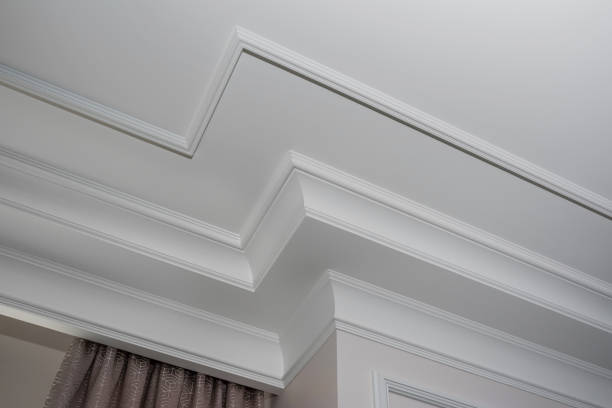
Popular Styles of Ceiling Trim
Crown Moulding
This fancy trim work hugs up against the ceiling, framing your space like a pro. Whether you want clean, contemporary lines or intricate old-world detailing, crown moulding brings drama and definition. It’s like giving your room a fabulous new haircut that makes jaws drop.
Beams
Typically made from solid oak planks or faux materials, these horizontal fellas bridge across rooms. These rustic hunks draw the eye upward and add so much warmth and texture. Stained dark, they’re total showstoppers. But even a light whitewash gives off modern farmhouse feels. Either way, beams make a statement overhead that’s both bold and welcoming at the same time.
Coffered Ceilings
These ceilings have a cool design with repeating square or rectangle shaped panels recessed into the ceiling. The recessed sections create neat shadow lines and geometric patterns overhead. Coffered ceilings make a space feel grand and sophisticated, kind of like those ornate ceilings you’d see in a historic building or castle. Yet they can still work in modern homes too!
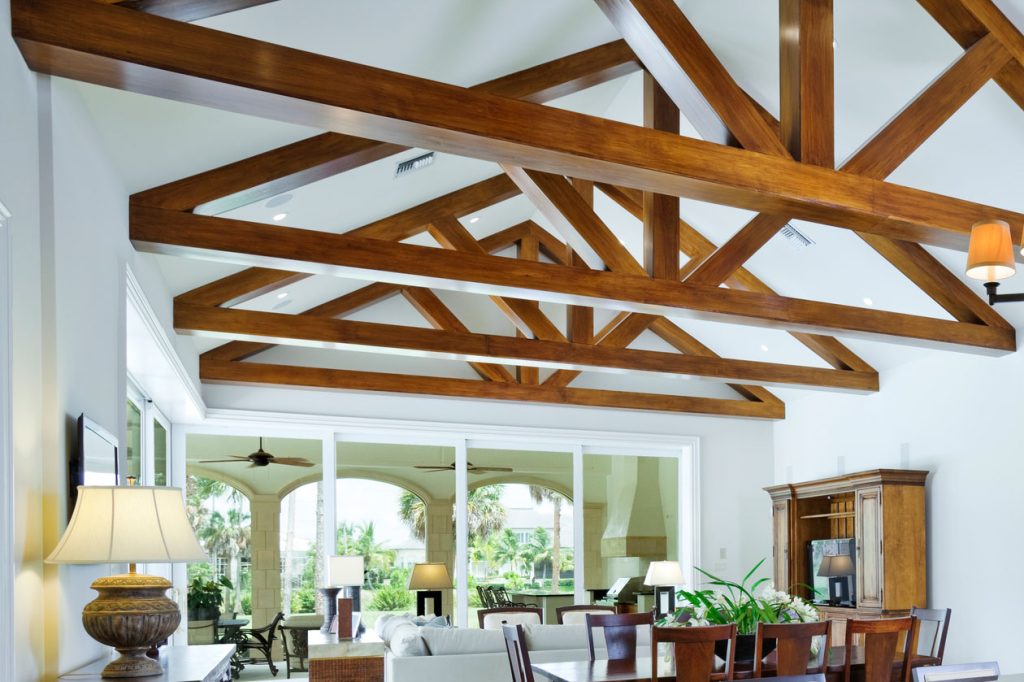
Tray Ceilings
Tray ceilings have angled sides that slope down towards the middle. It’s almost like looking inside a squared-off funnel shape.
- These slanted ceiling sections create a dramatic look by using different angled planes. They naturally draw your eyes upwards, making any room feel super tall and spacious.
- Way more interesting than just having a boring flat ceiling! The recessed center part casts nice shadows too. You can even add accent lighting or a pop of color inside that middle section.
- Tray ceilings are great for defining spaces like living rooms and bedrooms. The contoured design adds architectural flair and interest.
- They have a bit of a theatrical vibe, almost like a cool stage set design overhead. Yet the symmetrical edges keep things balanced and understated at the same time.
Corbels
Corbels are those decorative support pieces you often see on walls, ceilings, fireplaces, and arched entrances. They’re usually made from hand-carved wood or molded plaster.
- The shapely profiles of corbels mimic small beams or brackets, but their main purpose is to boost visual appeal. Some have simple, ledge-like designs for clean lines. Others flaunt intricate carved details like scrollwork that instantly grab your attention.
- By creating depth and interesting shadow patterns, corbels add lovely textural charm. They make great accents on their own or combined with crown molding along the ceiling.
- You can use corbels to dress up doors and windows too by integrating them right above the frames. So charming!
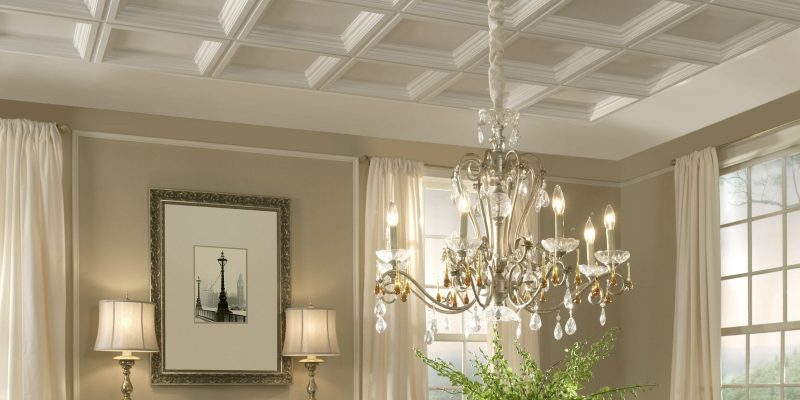
Ceiling Trim Ideas for Various Rooms
Entryways
Your home’s entryway is the first thing guests experience when they arrive. The ceiling in this space offers an opportunity to create an impactful first impression through stylish design elements.
One way to elevate your entryway ceiling is with crown moulding. This decorative trim runs along the top edges of the walls and frames the space in an elegant way that draws the eye upward. For a bolder look, consider exposed wood beams, which add warmth and rustic charm overhead.
Kitchens
The kitchen is the true heart and hub of any home, so the ceiling design should reflect its importance. Wood beams stretching across the ceiling not only highlight open shelving displays, but echo the warm tones of the cabinets and island for a cohesive look.
Alternatively, clean white crown molding helps the ceiling recede so the focus stays on lively tile backsplashes and countertops below. Open shelves allow natural light to filter through the space, with pendant lights hanging between the trim for ambient illumination.
For a cozier feel, you can create built-in nooks by painting the insides of crown molding with contrasting colors. Or add sophistication with indented, coffered ceiling panels which also enhance the room’s acoustics – perfect for lively kitchen chatter during meal prep.
Dining Rooms
The dining room needs a showstopping ceiling to match the grandiose table at the center. Formal, squared coffers exude sophisticated elegance befitting special occasions, while rustic wood beams and crisp mouldings lend a more casual, homey feel for everyday dinners.
To amp up the drama, install a multi-tiered tray ceiling with different angled heights. Then, hang a showstopping crystal chandelier in the lowest, sunken portion over the table below for maximum impact. Or use wallpaper between the angled tiers for extra coziness above.
Dining room ceilings have inspired memorable gatherings since medieval times. Follow that centuries-old tradition with artisan-carved wood beams, gilded moulding hinting at intimate dinner conversations of years past, and layers of light and shadow that set the perfect mood for making new memories over treasured family meals.
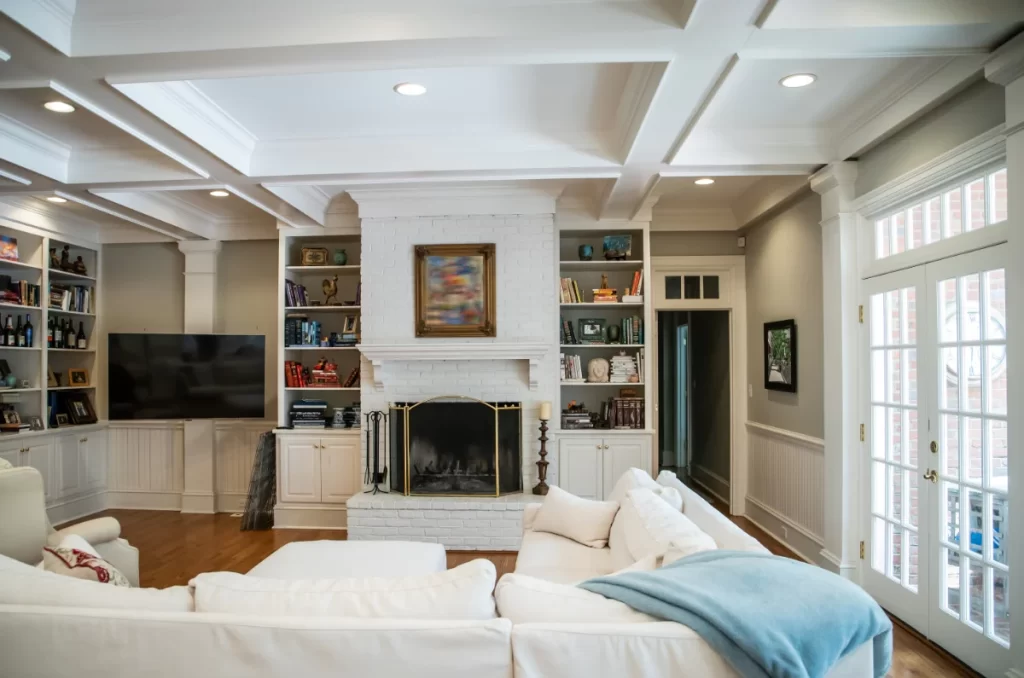
Living Rooms
Sloped tray ceilings are perfect for living rooms. The angled design naturally highlights cozy seating areas with well-placed downlights. While the shadows create a warm, inviting contrast. For a cozier vibe, pair lighter crown molding with richer wall colors. Or get rustic-refined with faux wood beams for vaulted ceilings. You can even hide rope lighting along the edges for a soft glowing effect.
Bedrooms
Make your bedroom a serene retreat! Crisp crown molding echoes a luxe hotel feel. Or extend wood plank headboards upward to the ceiling for cool textures. Want something whimsical? Hang bold medallions or stick-on clouds overhead! Tuck reading nooks and sconces into faux beams. Whatever style you like, the ceiling sets the tone for your day – from “sleep tight” to “good morning!”
Bathrooms
Bathrooms Use subtle rope lighting inside crown molding for an uplifting bathroom glow. Waterproof tiles let you get bold with mirrors that expand the space. Stack molding pieces or beams in corners for spa-like shelving nooks. Hang the showerhead from an ornate ceiling medallion. Or add carved corbels to echo those vanity mirrors. Whatever you choose, let the fancy ceiling complete your relaxing oasis!
Hallways
Cove lighting built into crown molding gently illuminates hallway art. Mini pendants over doorways keep the path bright too. Or use faux wood beams to guide visitors with rustic wayfinding vibes. Hand-paint the beams for pops of color. No matter your hallway treatment, the ceiling helps set the mood for an impressive stroll through your home.
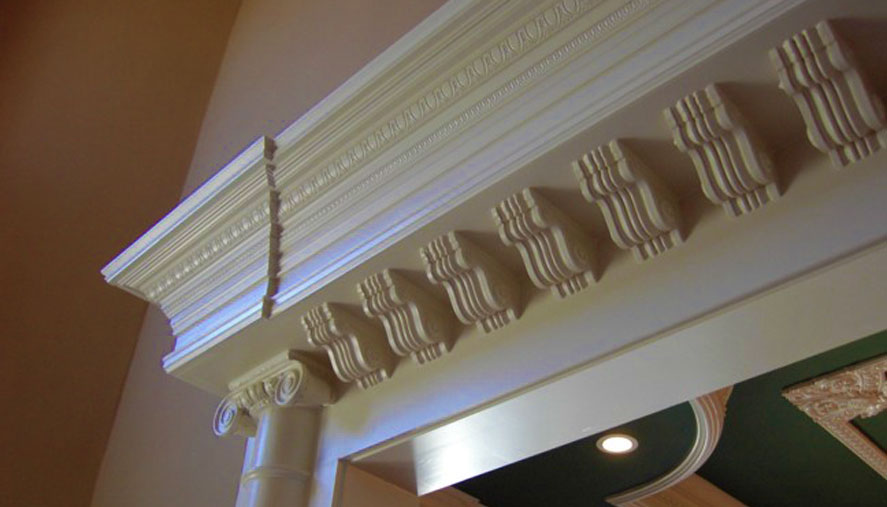
Design Considerations for Ceiling Trim
Room Proportions
Consider ceiling trim sizes and designs in relation to your room’s dimensions. For example, narrow crown moulding might get lost in an expansive living room. Similarly, bold beams could overwhelm a petite powder room.
Ceiling Height
In general, rooms with higher ceilings can handle bolder, wider ceiling trim styles. More subtle pieces keep lower ceilings feeling intimate yet still special. Just ensure there’s adequate clearance if truncating window or door openings.
Trim Materials
Wood trim offers a classic warmth that suits traditional decor. Whereas MDF or polyurethane pieces provide crisp, bright white lines fitting contemporary or modern schemes. Plaster and synthetic marble deliver ornate touches.
Architectural Style
Match your interior architectural style—whether modern farmhouse or art deco—with congruent ceiling treatments. Beams for Craftsman homes, crown moulding for Victorian spaces, etc. Unity promotes greater design harmony.
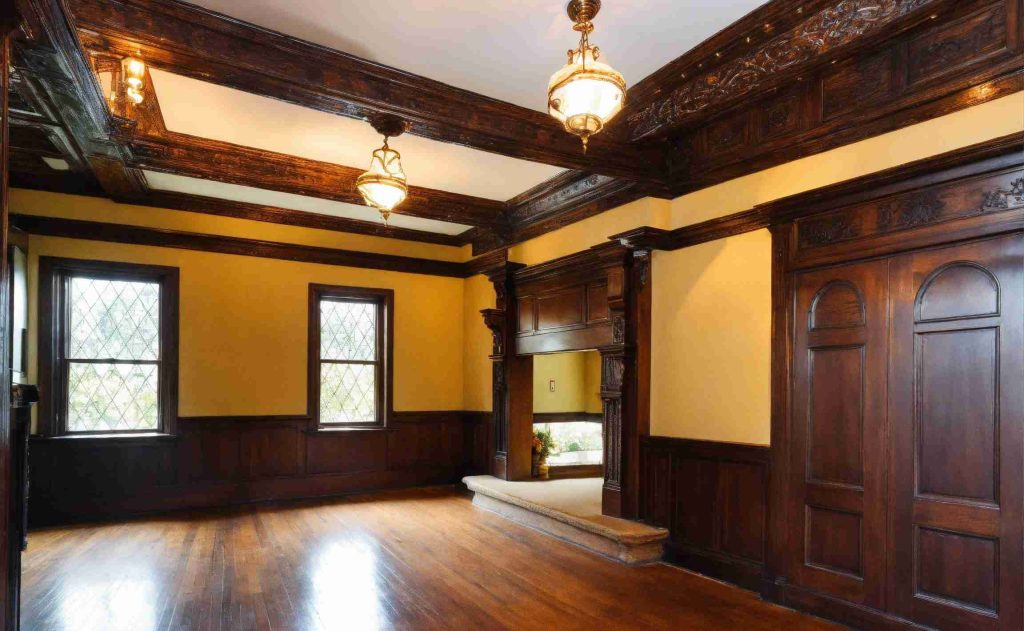
Budget
While intricate hand-carved crown moulding costs more, you can replicate looks for less with foam or plastic. Similarly, faux beams seem real but avoid expensive wood pricing. Just note cheaper pieces won’t last as long.
Color Scheme
If aiming for subtle contrast, select ceiling trim hues slightly lighter or darker than your wall color. Bolder ceiling extras pop more against neutral backdrops. And don’t forget to coat ceilings bright white; it makes the trim stand out more.
Prioritize Rooms
Focus ornate ceiling treatments only in rooms you use often and want to highlight, like the living room. Simplify accents elsewhere and upgrade down the road if desired. Start small if you’re unsure.
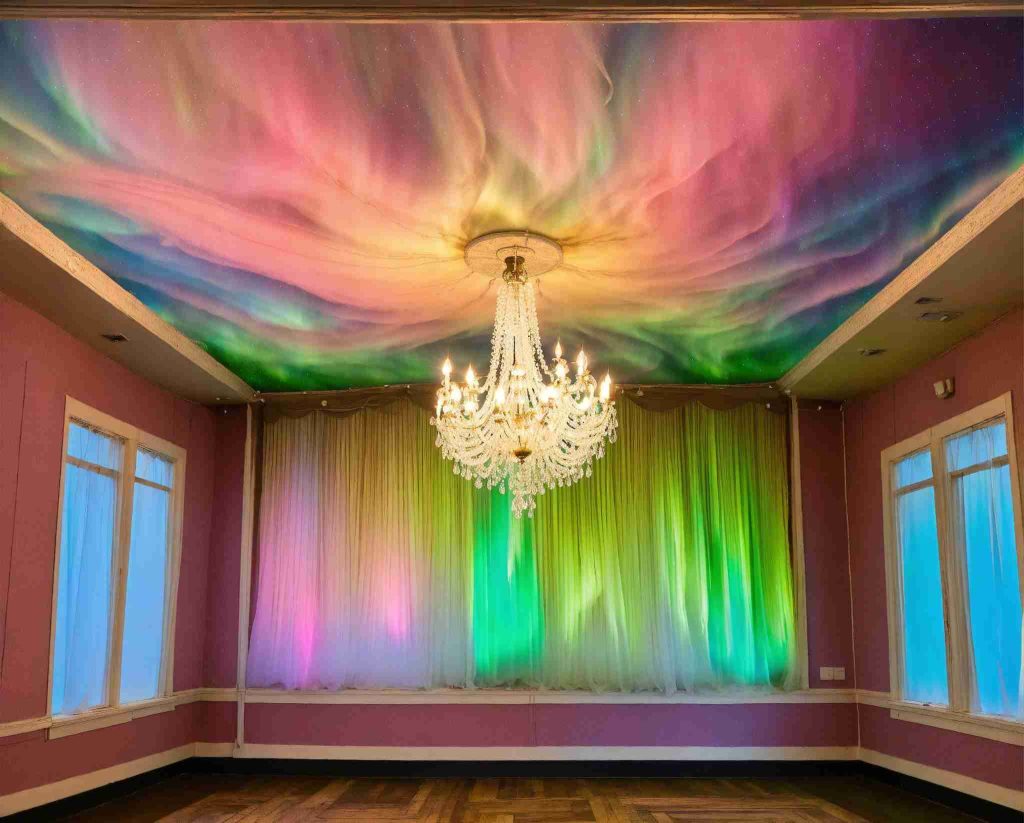
DIY vs Professional Installation
DIY projects include:
- Gluing decorative wall paper or faux finishes along ceilings
- Affixing stick-on beams or brackets with adhesive
- Mounting pre-made crown moulding using nails and construction adhesive
- Painting medallions, ceiling domes or borders using painter’s tape
Seeking professional help is best for:
- Load-bearing beams that require structural modifications
- Intricately carved or heavy molding
- Extensive wiring for new lighting, outlets or switches
- Rooms with tricky angles or inconsistencies
- Jobs requiring tall ladders or lift equipment
While DIY is cheaper, pros ensure things are level, secure and compliant with building codes. They also complete work much faster with fewer errors that require fixes down the road. Get contractor referrals and compare several bids.
Clever Ceiling Tile Ideas Beyond Basic White
If dreary, dotted ceiling tiles are bringing down your decor, it’s time to look up! Swapping out tired tiles for creative options adds character wherever you need it. From eye-catching patterns to custom paint jobs, explore clever ways to transform ugly overhead planes into an accent all their own.
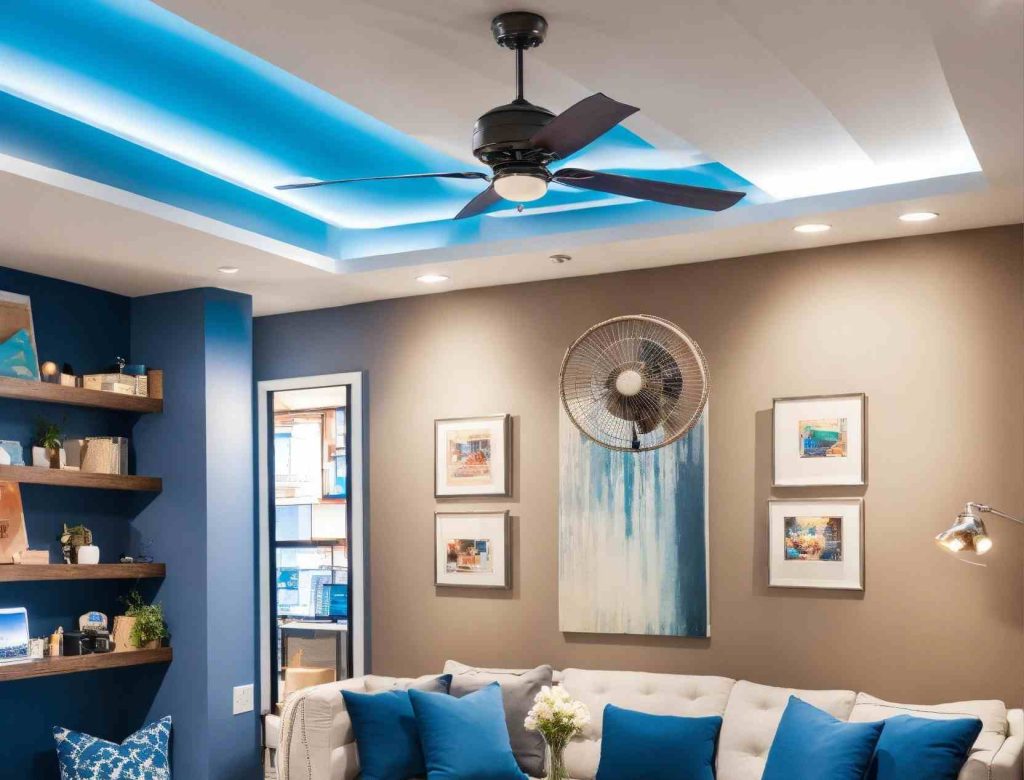
Types of Ceiling Tiles to Consider
| Faux Tin Tiles | Replicate an industrial chic look with metal-lookalike tiles in gray, copper or silver finishes. Affordable and lightweight. |
| Wood Planks | Rich wood grain pattern ceiling tiles infuse rustic warmth. Stained in lighter or darker hues. |
| Murals | Custom jigsaw puzzle-like tiles let you assemble colorful mural designs, like sunsets or forest scenes overhead. |
| Travertine, Marble, Slate | Sophisticated stone and marble-effect tiles create texture and opulent focal points in more formal spaces. |
| Mirrors | Mirror tiles open up rooms with light reflection and the illusion of height. Bounce back chandelier sparkle. |
| Perforated | Punch patterned tiles have eye-catching cutout dots or shapes that play with dimension. Uplifting in mod spaces. |
Style Considerations for Standout Ceiling Tiles
- Room purpose: Bold mirrored or mural tiles suit dining and living areas while intricate patterns can overwhelm bedrooms.
- Tile size: Larger tiles expand smaller rooms. More panels give traditional spaces grandeur.
- Color and pattern: Monochromatic tiles calm while contrasting colors and prints energize.
- Material finishes: Matte and natural textures relax while high-gloss and metallic choices excite.
- Home architecture: Rustic woods complement Craftsman homes as sleek perforated matches modern spaces, for example. Coordinate with your existing elements like cabinetry.
- Lighting: Ceiling tiles shouldn’t compete with elaborate chandeliers. Balance visual interest.
- Budget: Handpainted murals costs more than buying stock tiles. Prioritize key gathering rooms if needed.
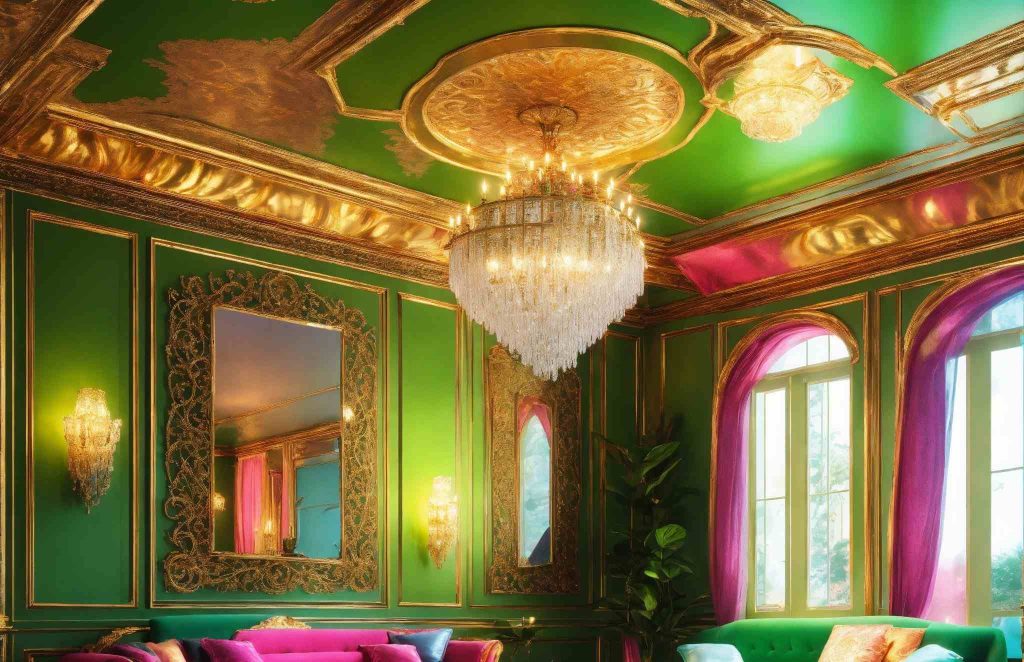
Customized Ceiling Tile Ideas
| Paint Effects | Add painter’s tape geometrics, faux clouds or freehand murals. Great for kid spaces. |
| Wallpaper | Adhere wallpaper remnants upside down or showcase special papers not practical on walls. |
| Collections | Arrange your travel postcards, album covers or plant photos into an artsy array overhead. |
| Downsize Artwork | Blow up favorite digital images like nature photos and print onto acrylic sheets for see-through “skylights”. |
Things to Consider with Ceiling Tile Revamps
- Material compatibility – Check that chosen tile weights work with existing substrate and joists first, especially in older homes.
- Insulation upkeep – Preserve proper insulation between floors by installing tiles correctly. This maintains energy efficiency and noise reduction.
- Electrical adjustments – Box in wires, lights, vents and sprinklers neatly before installing new tiles around them.
- Professional installation – Removing popcorn ceilings or adjusting building systems is complex. Consult licensed contractors.
- HOA regulations – If part of a condo or collective community, ensure tile designs meet association rules before installing.
- Gradual upgrades – For bigger spaces like basements or game rooms, divide grids into sections and upgrade tiles in phases to spread out costs overtime.
- Imperfect placements – Handmade murals and other high-contrast patterns highlight uneven alignments. Expect slight inconsistencies.
Ready for Showstopping Ceilings?
Tired of boring, basic ceilings? Any of these creative trim ideas can take your rooms from bland to beautiful by attracting the eye upward. Consider crown moldings, beams, recessed panels or other architectural accents to express your unique style. Maximize visual intrigue and depth while defining spaces in chic ways. Just be sure to scale details appropriately, unify room aesthetics and set realistic budgets. Then stand back and enjoy the gorgeous results overhead!


